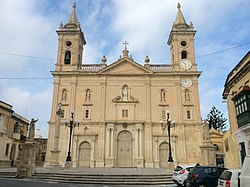Qormi
|
Qormi Ħal Qormi Città Pinto, Casal Fornaro, Casal Curmi |
|||
|---|---|---|---|
| City and Local council | |||

View of the Church of Saint George
|
|||
|
|||
| Motto: Altior ab Imo (Rising from the Low) |
|||
 |
|||
| Coordinates: 35°52′46″N 14°28′20″E / 35.87944°N 14.47222°ECoordinates: 35°52′46″N 14°28′20″E / 35.87944°N 14.47222°E | |||
| Country |
|
||
| Region | Southern Region | ||
| District | Northern Harbour District | ||
| Borders | Attard, Balzan, Birkirkara, Ħamrun, Luqa, Marsa, Santa Venera, Siġġiewi, Żebbuġ | ||
| Government | |||
| • Mayor | Rosianne Cutajar (PL) | ||
| Area | |||
| • Total | 5 km2 (2 sq mi) | ||
| Population (March 2014) | |||
| • Total | 16,779 | ||
| • Density | 3,400/km2 (8,700/sq mi) | ||
| Demonym(s) | Qormi (m), Qormija (f), Qormin/Qriema (pl) | ||
| Time zone | CET (UTC+1) | ||
| • Summer (DST) | CEST (UTC+2) | ||
| Postal code | QRM | ||
| Dialing code | 356 | ||
| ISO 3166 code | MT-43 | ||
| Zones | Fuq tal-Blat, Ħara l-Belha, San Bastjan, San Dwardu, San Ġorġ, Ta' Farsina, Tal-Ħandaq, Tal-Ħlas, il-Vitorja, il-Wied. | ||
| Patron saint |
St. George St. Sebastian |
||
| Day of festa | Last Sunday of June (St. George) 3rd Sunday of July (St. Sebastian) |
||
| Website | Official website | ||
Qormi (Maltese: Ħal Qormi [ħal ʔormi]; Ħar Qurmi in the Qormi dialect), also known by its title Città Pinto, is a city in the Southern Region of Malta, located southwest of Valletta in the centre of the island. It has a population of 16,779 (as of March 2014), which makes it the fifth largest locality in Malta.
The bordering towns of Qormi are Marsa, Luqa, Żebbuġ, Siġġiewi, Ħamrun, Birkirkara, Attard, Santa Venera and Balzan.
Qormi has two parishes, one dedicated to Saint George and one to Saint Sebastian. There are also two valleys in Qormi, Wied il-Kbir (The Large Valley), and Wied is-Sewda (Black Valley).
Elder inhabitants of Qormi speak a thick Qormi Dialect, yet this is now in decline.
There are indications of it being inhabited in antiquity. Bronze Age pottery was found in the area known as Stabal indicating presence of humans as early as 1500-800 BC. Punic tombs have been found at St Edward's Street and Tal-Bajjada. Also, some Ancient Roman remains were found in the valley of Wied il-Kbir. However, chances are that in these times, there were only small communities in the whereabouts of Qormi.
It was only in the Middle Ages that it started to grow and prosper, probably thanks to its proximity to the Grand Harbour and its central position. The first written reference to the town is made in 1417 where it is recorded that the town provided some 100 men to serve in the Dejma, the national guard.
...
Wikipedia


